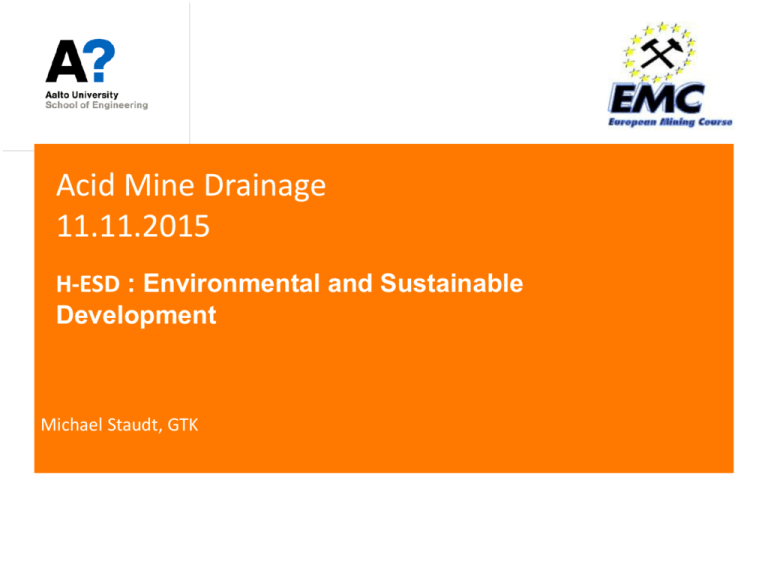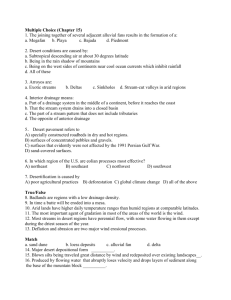Acid Mine drainage
advertisement

Acid Mine Drainage 11.11.2015 H-ESD : Environmental and Sustainable Development Michael Staudt, GTK Table of contents Acid Mine Drainage • Excercise • Steps of the excercise • Equations Managing Sulphidic Mine Wastes and Acid Drainage Acid Drainage Caused by the oxidation of sulphide minerals, especially iron sulphides, associated with mining Oxidation produces sulphate ion which when dissolved in water forms sulphuric acid Acid Drainage Some effects: Acid drainage affects water quality downstream Rehabilitation becomes more difficult Metal ions are released Acid Drainage Acid drainage is one of the most significant environmental issues facing the mining industry. Canadian liability estimated as C$ 2-5 billion Australian liability estimated as A$ 60M/year in the USA 20,000 km of streams and rivers adversely affected Longevity of the Problem • Acid drainage may not develop immediately • Acid drainage can continue for tens to thousands of years Rio Tinto region, Spain; for more than 2000 years Many examples more than 50 years with little reduction in rate of acidic drainage What is Acid Drainage? • Oxidation of sulphidic minerals, especially in connection with mining – Exposure to air and water – Increase in surface area – Reactive minerals • Pyrite (iron sulphide) most common sulphide mineral associated with mines • Other iron and other metal sulphides • Drainage of acid away from its source FeS2 + 3.75 O2 + 3.5 H2O = Fe(OH)3 + 2 SO42- + 4 H+ (Iron sulphide + Oxygen + Water = Ferric Hydroxide + Aqueous sulphuric acid) Factors Influencing Acid Drainage • • • • • • • Water (required for oxidation and transport) Oxygen availability Physical characteristics of the material Temperature, pH Ferric (Fe+3)/ferrous (Fe+2) ion equilibrium Microbiological activity Presence of neutralising minerals – Carbonates are most effective – Silicates & aluminosilicates may contribute • Chemistry of receiving waters Impacts of Acid Drainage • Potential for reuse of water on mine is limited – corrosion problems for equipment • Toxic effects to aquatic ecosystems – acidity and dissolved metals • Toxic effects on downstream vegetation • Adverse impacts on ground water • Limits uses of downstream water – Irrigation, stock watering, recreation, fishing • Causes difficulties in revegetation and stabilising mine wastes Best Practice Approach • During feasibility stages: – Characterise acid generating potential of materials – Characterise mobility of potential contaminants such as heavy metals – Estimate the potential for oxidation products to migrate to the environment – Estimate effects on host environment Identifying and Predicting Acid Drainage • When characterising rock types at site important characteristics include: – Geological description – Mineralogy of both ore and waste – Fracturing • Sampling and analysis: – Acid-base accounting – Simulated oxidation, usually with hydrogen peroxide – pH and conductivity tests of paste or slurry – Total and soluble metal analysis – Geochemical Kinetic Tests • Humidity cells • Column Leach Tests Acid Drainage Control Strategies • Control requires: – Data on physical and chemical properties of materials – Risk assessment – Strategies to minimise oxidation • Control strategies – Containment and isolation – Treatment of acid drainage Soil Covers • Materials – Imported materials e.g. clay, soil – Low-sulphide waste rock, if compactable – Geotextile fabrics – Covers may require zones • Base (main sealing) layer - high water retention, low permeability • Middle layer - water reservoir (may have higher permeability) • Surface layer (barrier zone) - erosion protection and/or substrate for plant growth Isolation Revegetated and c ontoured c over material (surface c apping and water storage m edium ) Top non-sulphidic waste layer Free dumped non-sulphidic waste Sulphid ic waste Basal layer Original ground surfac e 15 BEST PRACTICE ENVIRONMENTAL MANAGEMENT IN MINING Free dumped non-sulphid ic waste Water Covers • Most readily used in high rainfall, low evaporation areas • Creation of a permanent lake or swamp • Use of an existing lake or the sea • Flooding of underground tunnels and pits Blending • Mixing of acid and non-acid forming waste rock • Incorporation of alkaline materials •Lime •Fly ash •Kiln dust Bacterial Inhibition Bacteria can catalyse sulphide oxidation Applying bactericides can slow the process Effect may be short-term only Some success claimed in USA coal industry Used in establishing a vegetation cover before acid production starts Treatment Systems • Collection of acid drainage followed by neutralisation – Passive Anoxic Limestone Drains (PALID) • Drainage passed through a channel of coarse limestone gravel in the absence of oxygen – Successive Alkalinity Producing Systems (SAPS) • Variation on PALID – Wetland treatment systems • Newer treatments, moving from experimental to operational – – – – Bioreactors KAD (kaolin amorphous derivative) Bauxite derivatives ‘Green rust’ precipitation Passive Treatment Systems Cross section through an anoxic limestone drain 19 BEST PRACTICE ENVIRONMENTAL MANAGEMENT IN MINING Treatment Systems Conceptual design of a wetland system for treating Acid Mine Drainage 20 BEST PRACTICE ENVIRONMENTAL MANAGEMENT IN MINING Monitoring An essential component of sulphidic waste management • Classification of materials • Point source monitoring • Monitoring surface water and ground water in both up- and down-stream gradients • Monitoring of effectiveness of control measures Monitoring Rock materials: Waters: •Static and kinetic geochemical tests •Water flux through stockpiles •Physical stability: cracking, erosion •pH, conductivity, SO4-2 •Other major ions (Ca+2, Mg+2, Al+3, Na+, K+) •Alkalinity •Metals/metalloids (Fe, Al, As, Cd, Cu, Zn, Mn, Pb) •Toxicity to organisms





